Splitting the Political Spectrum into Social and Economic
Hi Everyone,

Source: Image created using Bing Images
In my 2020 post, ‘Exploring the Political Spectrum’, I outlined an octagon model to represent the political spectrum. The political spectrum is often depicted over a one-dimensional spectrum of left and right ideologies. This spectrum has no real basis, as the terminology of ‘left’ and ‘right’ is highly subjective and is changed frequently to align with prevailing agendas. I offered an alternative model to represent the political spectrum. It was built on three axes. These are globalism and nationalism, individualism and collectivism, and freedom and order. This model forms a cube. However, a cube is hard to represent on a two-dimensional medium such as print. Therefore, I represented the axes in an octagon model. See Figure 1 below.
Figure 1: Political Spectrum Octagon Model
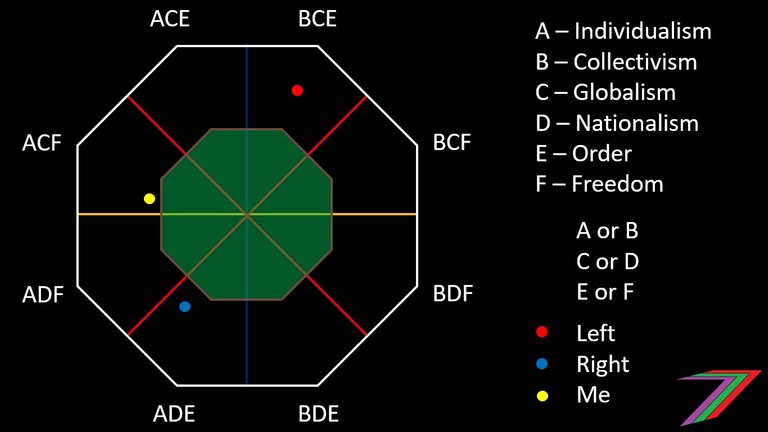
The model is more comprehensive and less subjective than the one-dimensional model. It is intended for people to place themselves on this model and identify where political parties and candidates sit in this model. The post includes an example of where I believe the current parties of the left and right sit.
In my post, If We Want to Change the World, We Need to Work Together, I reintroduced the octagon model. I attempted to expand it to include political movements such as democratic socialism, conservatism, liberalism, and libertarianism. I also included ideology that I considered should be placed at the points of the octagon (i.e., most extreme ideologies). This was difficult to do, as even extreme ideologies are not necessarily extreme in all aspects and therefore do not ideally sit at a point. I do not feel satisfied with all the selected extremes.
Figure 2: Octagon Model with Labelled Points
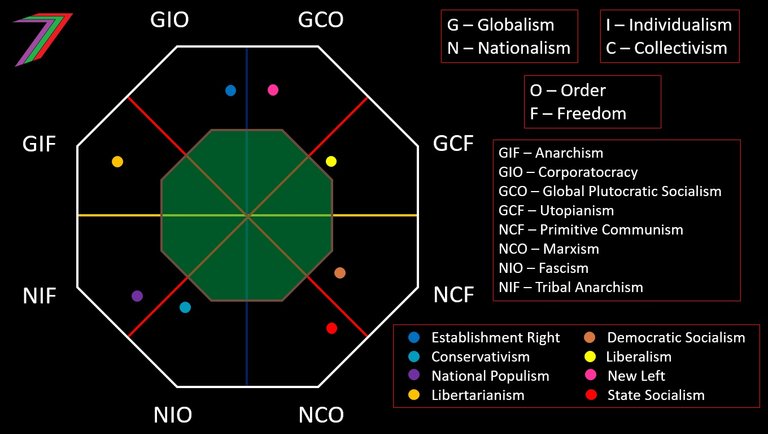
Note: Placement of political ideologies is subject to my own perceptions.
In my post, Applying the Octagon Model to the Political Spectrum, I took the octagon model one step further. I attempted to assign an ideology to the centre of the sides of the octagon (i.e., two extremes out of the three). I believe doing this could be useful, as it shows a quick comparison of the extreme ideologies with any other political ideology. The biggest problem with this approach is the extent of subjectivity around the application and understanding of these ideologies. For example, fascism. It is highly authoritarian and nationalistic. However, it varies in regard to collectivism. The ideology of Italian fascism was considerably more collectivist than Nazi fascism. Italian fascism was moulded off Bolshevism. At one point, Mussolini even referred to himself as the ‘Lenin of Italy’ (Wikipedia). Socialist and communist ideology is often used as bait to lure people into supporting totalitarian-type ideologies such as fascism.
Figure 3 contains my attempt to capture as many ideologies as I could within the octagon model.
Figure 3: Octagon Model with Attempted Capture of Various Political Ideologies
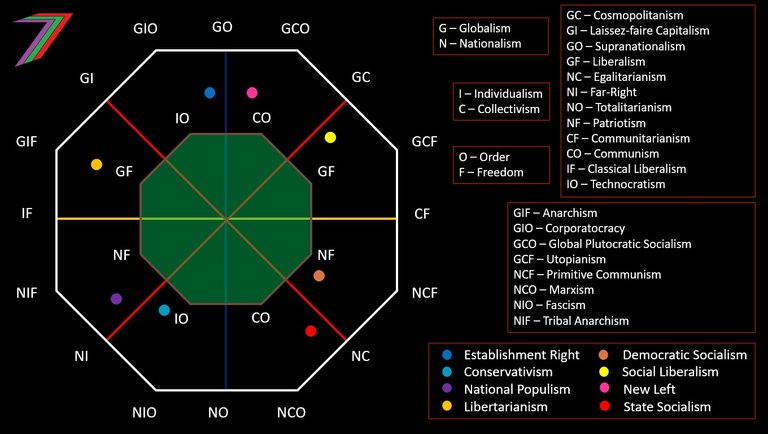
Upon further inspection, this model and the ideologies shown in it are not a great match. It is not possible to find real-world examples to fit as ideal types for all sides and points. Doing so is more misleading than helpful. It would be better to identify a relevant political ideology and place it somewhere on the spectrum.
Another problem with the model is that economic and social ideologies are treated as one, which is not the case for many political ideologies. For example, an ideology can support economic globalism but not social globalism. This could mean strong support for free trade between countries but not necessarily support for the flow and exchange of culture and values between countries. This potential inconsistency makes it difficult to accurately place this ideology in the model. Therefore, in this post I split the model into two octagons, one for the economic and one for the social aspect of an ideology.
Social and Economic Political Spectrum Model
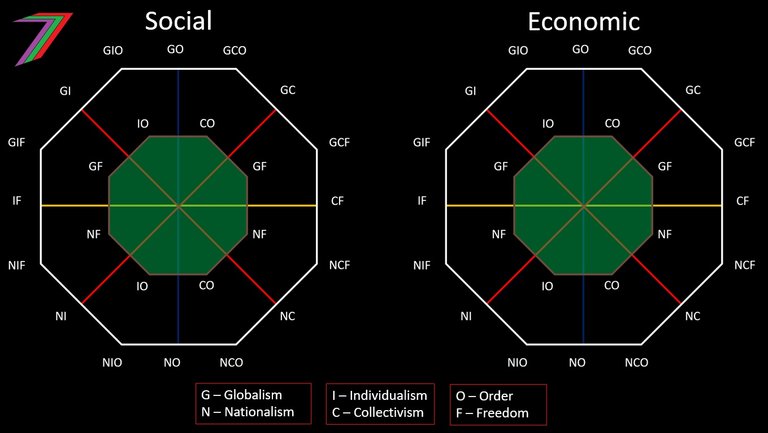
Social and economic aspects of globalism, nationalism, collectivism, individualism, order, and freedom focus on different things. In this section, I distinguish between the two. Many ideologies are consistent, but not all, and many people feel more strongly about one than the other.
Social Aspect of Globalism
The social aspect of globalism is focused on promoting multiculturalism and ethnic diversity. It encourages the blending of different cultures and practices. People are strongly encouraged to migrate to these countries. Immigrants are warmly welcomed, treated with respect, and encouraged to stay. At the extreme end of this scale, people believe that no national culture should exist, but instead culture is fluid and ever-changing. The leadership of countries such as Canada and many of the European Union countries strongly support the social aspects of globalism.
Social Aspect of Nationalism
The social aspect of nationalism is focused on preserving a country’s national identity and interests. It focuses on putting the country’s citizens first. Immigrants are generally welcome but are expected to respect the country’s national identity and to prioritise that above their own customs. They are not treated equally to the citizens of the country but are still offered opportunities to succeed and eventually make the country their home. At the extreme end of this scale, people believe that the established national culture should be the only culture that should exist.
Economic Aspect of Globalism
The economic aspect of globalism focuses on encouraging international trade. This includes the trading of goods and services as well as the movement of capital. These should not be hindered by either excessive restrictions or regulations. The movement of people is encouraged if it enables trade between countries. At the extreme end of this scale, people believe there should be absolute free trade between all countries.
Economic Aspect of Nationalism
The economic aspect of nationalism focuses on domestic economic activity. Trade with other countries is restricted. This could be through regulation or tariffs. The intent is to protect domestic producers from overseas competition. This competition may produce high-quality or cheaper goods and services. This is because they could have an advantage in certain areas. They might have better technology, or they might be using cheap labour. At the extreme end of this scale, people believe the country should have a completely closed economy with only domestic trading.
Social Aspect of Collectivism
The social aspect of collectivism focuses on the needs of the group over the individual. People are expected to help each other out whenever necessary. The young help the old. The strong help the weak. It promotes strong family and community bonds. It is considered a social norm and is expected to occur naturally as part of the culture. However, the group will exert pressure on those less willing to cooperate. At the extreme end of the scale, people are required or expected to act only in the best interests of the group. Members are even willing to sacrifice themselves if necessary.
Social Aspect of Individualism
The social aspect of individualism focuses on the needs of the individual over the group. It is believed that if individuals focus on their self-interests, it will result in the benefit of the group. It encourages people to compete with each other. This is believed to bring out the best in people. Therefore, overall, society benefits from the success of individuals. At the extreme end of the scale, there are no requirements for people to actively support the collective.
Economic Aspect of Collectivism
The economic aspect of collectivism focuses on the sharing of resources and economic outputs. Those who have more wealth or higher income are expected to share this with those who earn less or are less economically wealthy. This is often done through income and wealth taxes. Progressive taxes are used to extract wealth from the highest earners. This wealth is intended to be redistributed to the lowest income earners. At the extreme end of the scale, it is believed all resources and economic output should be divided equally among all, regardless of the contributions made by each person.
Economic Aspect of Individualism
The economic aspect of individualism focuses on giving people autonomy over their own earnings and wealth. Income and wealth taxes are to be minimised but are generally accepted to be still progressive to a certain extent. Some might promote voluntary redistribution of wealth from the richest to the poorest. The strongest argument for this belief is that people will be more incentivised to be successful in earning income if they know they will receive minimal help if they do not. At the extreme end of the scale, there are no income or wealth taxes. People are forced to survive purely on what they earn and/or from voluntary payments and donations from the wealthier.
Social Aspect of Order
The social aspect of order focuses on structure, hierarchy, rules, and regulations. These are set in place to maintain stability, security, and safety. Punishments for violating laws are strict. These act as both punishments and deterrents. At the extreme end of the scale, authority has absolute control over even everyday life. This would include surveillance and monitoring of almost all activity.
Social Aspect of Freedom
The social aspect of freedom focuses on freedom from forceful actions by institutions and authority. Freedom of speech and expression is granted and protected; censorship is minimal or nonexistent. Rules and regulations still exist, but they are not intended to prevent basic freedoms. At the extreme end of the scale, people are given almost absolute freedom outside of force or violence.
Economic Aspect of Order
The economic aspect of order focuses on control over demand and supply. This typically involves Governments strongly regulating and intervening in producing and distributing resources. Typically, State ownership of industry is high. This occurs through nationalising private businesses or through starting new State owned enterprises. For industries not controlled by the Government, regulations and laws are strict. Over recent decades, there has been a stronger push towards controlling demand rather than supply. Governments raise taxes to make decisions on behalf of the public. Instead of running State owned enterprises, they outsource to the private sector. Government spending remains high despite not employing as many people as they would if they ran businesses themselves. At the extreme end of the scale, the Government makes all purchasing, production, and distribution decisions themselves.
Economic Aspects of Freedom
The economic aspect of freedom focuses on leaving demand and supply in the hands of free markets. People determine their own needs and wants. Businesses attempt to address these needs and wants by producing goods and services. Many different businesses compete with each other to best address people’s needs and wants. The businesses that can do this best succeed, while the ones that cannot typically fail. At the extreme end of the scale, there is intervention from the Government and State. The fate of businesses is determined purely by their ability to profitably meet their customers’ needs and wants.
Applying the Social and Economic Political Spectrum to the Real World
There are many different political ideologies, and the understanding and application of these ideologies will vary from one country to another. For example, liberalism in Australia is focused on the economic aspects of liberalism. Therefore, it is not compatible with ‘left-wing’ ideology. However, in the UK, liberalism is focused on the social aspects of liberalism. Therefore, it is more aligned with ‘left-wing’ ideology.
In Figure 4, I have placed eight different political ideologies in both the social and economic spectrums of the model. These placements are based on my own subjective beliefs regarding where I feel they fall on the spectrums. The same can be done with political parties.
Figure 4: Placing Ideologies in the Social and Economic Octagon Models

For some ideologies, there is consistency between social and economic aspects. For example, libertarianism, social liberalism, and state socialism. For others, the ideologies converge significantly. For example, conservatism and the New Left.
A key part of western conservative ideology is national identity, traditional values, and cultural heritage. Therefore, it supports the social aspects of nationalism and order and leans towards individual responsibility over collectivism. However, another key aspect of western conservatism is strong support for free trade and international trade. This indicates that western conservativism supports the economic aspects of globalism and freedom.
A key part of the new left ideology (e.g., recent European ‘left-wing’ ideology that has a strange social liberal twist to it) is cultural and ethnic diversity and enforced support for minorities. Therefore, it supports the social aspects of globalism, order, and collectivism. However, another key aspect of the New Left ideology is economic protectionism. This is not immediately apparent because of free trade within the European Union. I would argue the European Union is focused on the social aspects of globalism, and the economic aspects are tethered to that for countries in the union. For trade with countries outside of the European Union, there are strict regulations and terms. Many countries comply with their strict regulations because the European Union has such a huge market. Therefore, I believe the New Left ideology leans slightly towards nationalism over globalism. This is based on the assumption that the European Union behaves almost like a giant European country when it comes to international trade.
I have also included my own personal beliefs in both octagon models. In terms of the social aspects, I lean slightly towards globalism over nationalism. I believe in the relative free movement of people and the value of certain aspects of diverse culture. However, I also believe national culture comes above any form of imported culture and that migrants should respect and honour that above their own. I feel it is easier to support this belief, as I am opposed to the economic aspects of collectivism. I believe people should be welcomed to another country but not given any economic support at all.
I also lean towards the social aspects of individualism but not as strongly as the economic aspects. I believe society has a responsibility to help the less fortunate born into our society. I more strongly support the economic aspects of freedom than the social aspects of freedom. I believe trade should be as unregulated as possible. However, I also believe laws are important to maintain order. I believe the main purpose of laws should be to protect people’s freedom. I do not believe absolute freedom is possible because there will always be others who wish to take it away. Therefore, laws should be implemented to prevent them from doing so.
Conclusion
The political spectrum is considerably more complex than a simple left-right paradigm. Even using three axes is still an oversimplification considering the complexities of some ideologies. Splitting the spectrum into social and economic can add clarity when there are possible contradictions. Splitting the spectrum should also make it easier for people to self-assess their own political opinions.
The Sapien Loop Series

I am writing a trilogy of books titled Sapien Loop. The first in the series is Sapien Loop: End of an Era and the second is Sapien Loop: Frozen in Time. I published both of these books as ebooks on Amazon, and I have posted completed chapters to my @captainhive account. I anticipate publishing the third book in early 2027. I expect to title this book Sapien Loop: Worlds Collide. In 2025, I plan to write short stories about some of the characters and their adventures. I will post these to my @captainhive over the course of the year.
Brief Summary of Sapien Loop: End of an Era
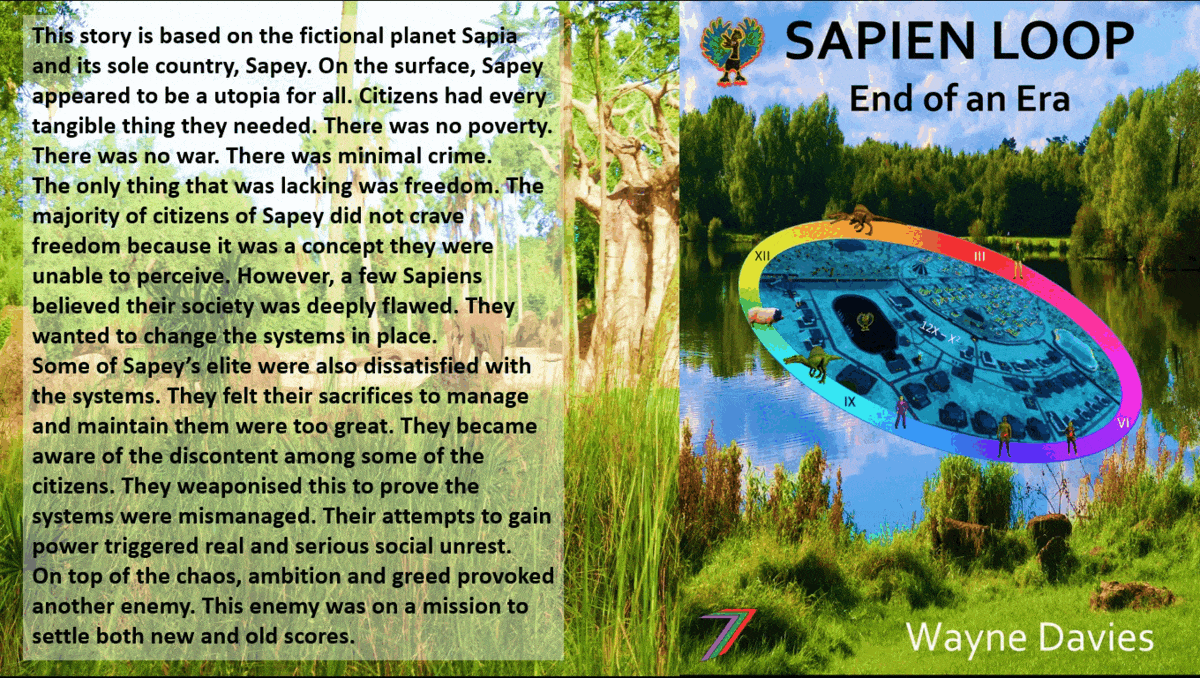
This story is based on the fictional planet Sapia and its sole country, Sapey. Sapey is portrayed as a form of utopia for all its citizens. No poverty. No war. Almost no crime. Opportunities for all.
This was enough for most citizens, but not all. In one of the small regions, some of the citizens had become discontent. They felt something important was missing in their lives. Their discontent did not go unnoticed. Some of the Sapey elite wanted to weaponise this discontent to gain more power. This created more chaos than they anticipated. This led to further widespread social unrest.
On top of the chaos, ambition and greed provoked another enemy. This enemy was on a mission to settle both new and old scores.
Brief Summary of Sapien Loop: Frozen in Time
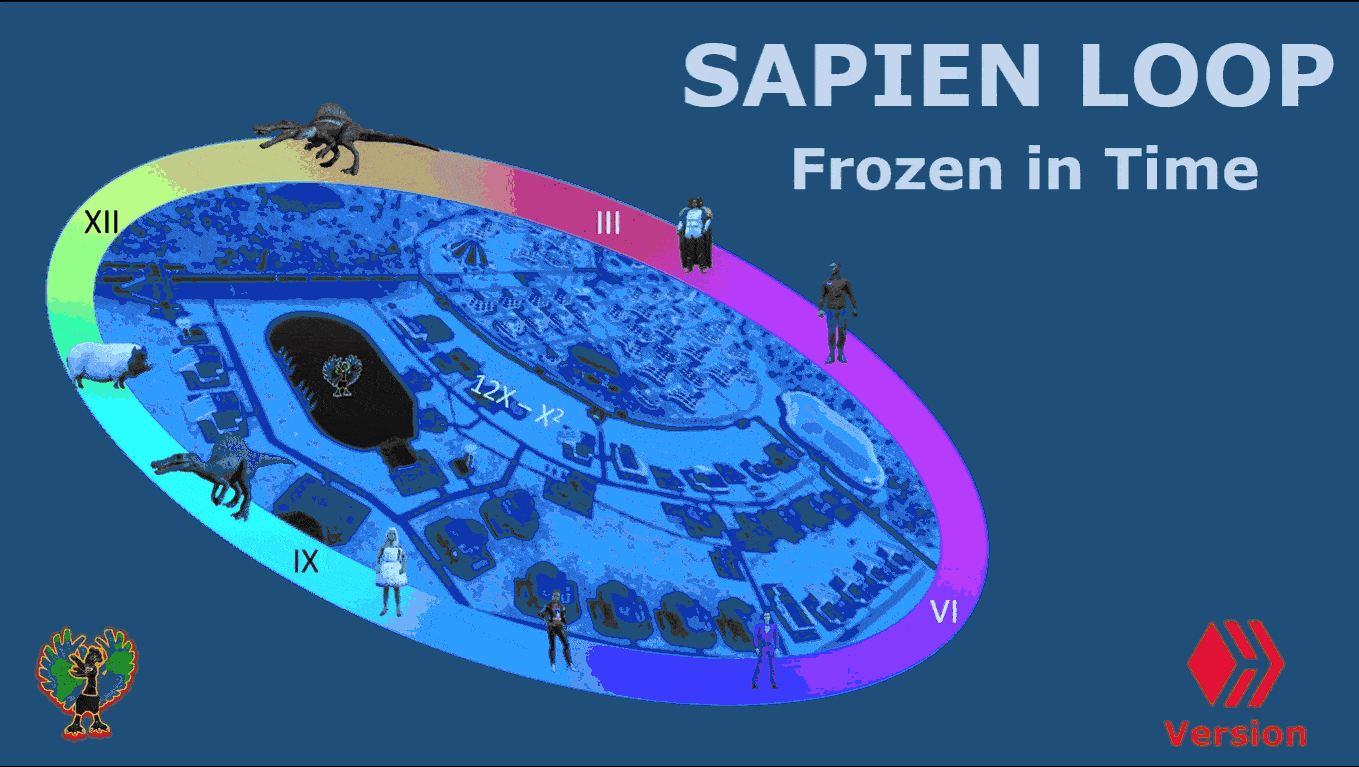
This story is based six years after the original story. The Downs Region is still suffering from a serious health crisis caused by the contaminated water. The main characters are desperately trying to a find a cure for the illness that has been caused by the water.
One of the main characters has discovered frozen humanoids in hidden chambers. It appears they have been frozen for a long time. These chambers connect to a vast network of tunnels. While exploring the tunnels, one of the frozen humanoids disappears. It appears he has been stolen.
The story takes a step back in time to tell the story of the frozen humanoids. How and why were they frozen? This part of the story also explains the fall of ancient Sapey and the birth of the Sapiens. Can those from the past be able to coexist with those from the present?
Hive: Future of Social Media
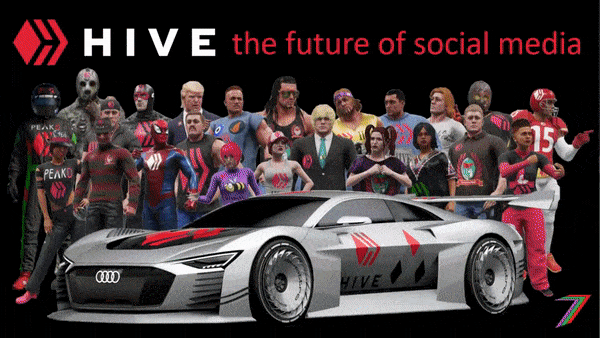
Spectrumecons on the Hive Blockchain

Awesome write up! Have you had a chance to take a look at our proposal? We would love your support as we are very close to completing the funding round. Please consider it here: https://peakd.com/me/proposals/346
Sounds interesting. Sure, I'll support it.
You described freedom from a very American perspective. You have it as a right to do something which means that the more powerful you are, either through ownership or money the more "freedom" you have to abuse power.
Many other nations/peoples regard freedom as something different. Freedom from the abuse of the powerful and freedom from debt. We are all born into a world that is owned by someone. If we are lucky we are born into wealth which means that our parents can provide for us without us having to acquire more debt. If we are born poor that means that we are born into debt and at some point will have to work to get out of it and put a roof over our heads. ie. the very concept of land ownership puts the poorest in debt slavery, the antithesis of freedom.
So is freedom the right of the individual, the state or the corporation to do things to say things and do things to others or the freedom from having shit thrown at you every day by the powerful? It's a perspective thing and more accurately a cultural programming thing. However, consider that any nation that has to remind you every single day of a particular national vanity then it should be viewed as propaganda that is used to distract you or misdirect you.